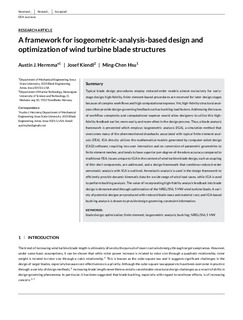| dc.description.abstract | Early‐stage wind turbine blade design usually relies heavily on low‐fidelity structural models; high‐fidelity, finite‐element‐based structural analyses are reserved for later design stages because of their complex workflows and high computational expense. Yet, high‐fidelity structural analyses often provide design‐governing feedback such as buckling load factors. Mitigation of the issues of workflow complexity and computational expense would allow designers to utilize high‐fidelity feedback earlier, more easily, and more often in the design process. Thus, a blade analysis framework that employs isogeometric analysis (IGA), a simulation method that overcomes many of the aforementioned drawbacks associated with traditional finite element analysis (FEA), is presented. IGA directly utilizes the mathematical models generated by computer‐aided design (CAD) software, requiring less user interaction and no conversion of parametric geometries to finite element meshes. Furthermore, IGA tends to have superior per‐degree‐of‐freedom accuracy compared with traditional FEA. Issues unique to IGA in the context of wind turbine blade design, such as coupling of thin‐shell components, are addressed, and a design approach that combines reduced‐order aeroelastic analysis with IGA is outlined. Aeroelastic analysis is used to efficiently provide dynamic kinematic data for a wide range of wind load cases, while IGA is used to perform buckling analysis. The value of incorporating high‐fidelity analysis feedback into blade design is demonstrated through optimization of the NREL/SNL 5 MW wind turbine blade. A variety of potential designs are produced with reduced blade mass and material cost, and IGA‐based buckling analysis is shown to provide design‐governing constraint information. | nb_NO |
